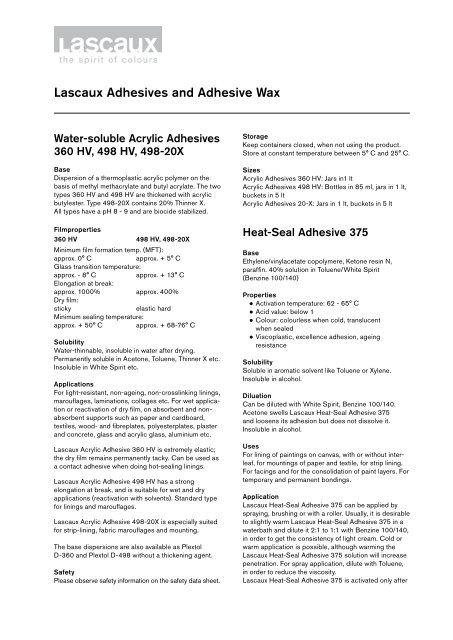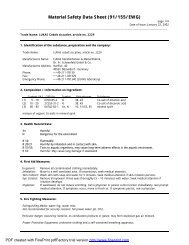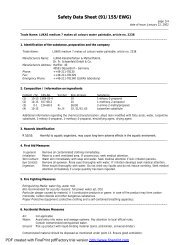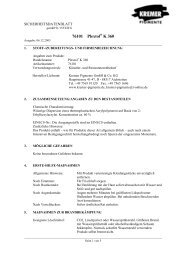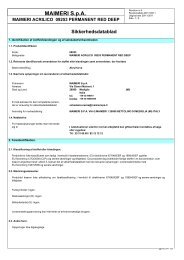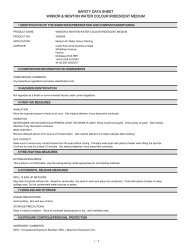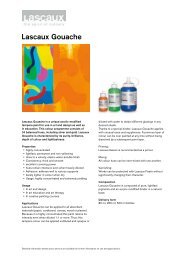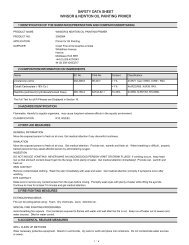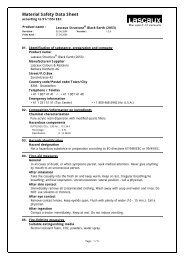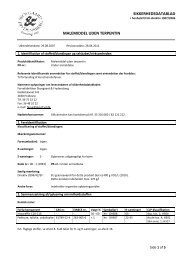Lascaux Adhesives and Adhesive Wax - Aart de Vos
Lascaux Adhesives and Adhesive Wax - Aart de Vos
Lascaux Adhesives and Adhesive Wax - Aart de Vos
Create successful ePaper yourself
Turn your PDF publications into a flip-book with our unique Google optimized e-Paper software.
<strong>Lascaux</strong> <strong><strong>Adhesive</strong>s</strong> <strong>and</strong> <strong>Adhesive</strong> <strong>Wax</strong>Water-soluble Acrylic <strong><strong>Adhesive</strong>s</strong>360 HV, 498 HV, 498-20XBaseDispersion of a thermoplastic acrylic polymer on thebasis of methyl methacrylate <strong>and</strong> butyl acrylate. The twotypes 360 HV <strong>and</strong> 498 HV are thickened with acrylicbutylester. Type 498-20X contains 20% Thinner X.All types have a pH 8 - 9 <strong>and</strong> are bioci<strong>de</strong> stabilized.Filmproperties360 HV 498 HV, 498-20XMinimum film formation temp. (MFT):approx. 0° Capprox. + 5° CGlass transition temperature:approx. - 8° Capprox. + 13° CElongation at break:approx. 1000% approx. 400%Dry film:stickyelastic hardMinimum sealing temperature:approx. + 50° C approx. + 68-76° CSolubilityWater-thinnable, insoluble in water after drying.Permanently soluble in Acetone, Toluene, Thinner X etc.Insoluble in White Spirit etc.ApplicationsFor light-resistant, non-ageing, non-crosslinking linings,marouflages, laminations, collages etc. For wet applicationor reactivation of dry film, on absorbent <strong>and</strong> nonabsorbentsupports such as paper <strong>and</strong> cardboard,textiles, wood- <strong>and</strong> fibreplates, polyesterplates, plaster<strong>and</strong> concrete, glass <strong>and</strong> acrylic glass, aluminium etc.<strong>Lascaux</strong> Acrylic <strong>Adhesive</strong> 360 HV is extremely elastic;the dry film remains permanently tacky. Can be used asa contact adhesive when doing hot-sealing linings.<strong>Lascaux</strong> Acrylic <strong>Adhesive</strong> 498 HV has a strongelongation at break, <strong>and</strong> is suitable for wet <strong>and</strong> dryapplications (reactivation with solvents). St<strong>and</strong>ard typefor linings <strong>and</strong> marouflages.<strong>Lascaux</strong> Acrylic <strong>Adhesive</strong> 498-20X is especially suitedfor strip-lining, fabric marouflages <strong>and</strong> mounting.The base dispersions are also available as PlextolD-360 <strong>and</strong> Plextol D-498 without a thickening agent.SafetyPlease observe safety information on the safety data sheet.StorageKeep containers closed, when not using the product.Store at constant temperature between 5° C <strong>and</strong> 25° C.SizesAcrylic <strong><strong>Adhesive</strong>s</strong> 360 HV: Jars in1 ltAcrylic <strong><strong>Adhesive</strong>s</strong> 498 HV: Bottles in 85 ml, jars in 1 lt,buckets in 5 ltAcrylic <strong><strong>Adhesive</strong>s</strong> 20-X: Jars in 1 lt, buckets in 5 ltHeat-Seal <strong>Adhesive</strong> 375BaseEthylene/vinylacetate copolymere, Ketone resin N,paraffin. 40% solution in Toluene/White Spirit(Benzine 100/140)Properties●●Activation temperature: 62 - 65° C●●Acid value: below 1●●Colour: colourless when cold, translucentwhen sealed●●Viscoplastic, excellence adhesion, ageingresistanceSolubilitySoluble in aromatic solvent like Toluene or Xylene.Insoluble in alcohol.DiluationCan be diluted with White Spirit, Benzine 100/140.Acetone swells <strong>Lascaux</strong> Heat-Seal <strong>Adhesive</strong> 375<strong>and</strong> loosens its adhesion but does not dissolve it.Insoluble in alcohol.UsesFor lining of paintings on canvas, with or without interleaf,for mountings of paper <strong>and</strong> textile, for strip lining.For facings <strong>and</strong> for the consolidation of paint layers. Fortemporary <strong>and</strong> permanent bondings.Application<strong>Lascaux</strong> Heat-Seal <strong>Adhesive</strong> 375 can be applied byspraying, brushing or with a roller. Usually, it is <strong>de</strong>sirableto slightly warm <strong>Lascaux</strong> Heat-Seal <strong>Adhesive</strong> 375 in awaterbath <strong>and</strong> dilute it 2:1 to 1:1 with Benzine 100/140,in or<strong>de</strong>r to get the consistency of light cream. Cold orwarm application is possible, although warming the<strong>Lascaux</strong> Heat-Seal <strong>Adhesive</strong> 375 solution will increasepenetration. For spray application, dilute with Toluene,in or<strong>de</strong>r to reduce the viscosity.<strong>Lascaux</strong> Heat-Seal <strong>Adhesive</strong> 375 is activated only after
all solvents required for its application have evaporated(12-24 hours).For lining <strong>Lascaux</strong> Heat-Seal <strong>Adhesive</strong> 375 is bestapplied either on the lining canvas or on an interleaf(e.g. polyester non woven). Heat activation after dryingof the solvents at approx. 62 - 65° C on a hot table, orwith an iron or a hot air blower. Heat activation can bedone days or week after application of the Lacaux Heat-Seal <strong>Adhesive</strong> 375.If <strong>Lascaux</strong> Heat-Seal <strong>Adhesive</strong> 375 is used for the consolidationof paint layers, it should be diluted 1:4 Benzine100/140 or White Spirit, or with Toluene toincrease penetration (check solubility of paint layerfirst). Heat activation after complete evaporation of thesolvents <strong>and</strong> un<strong>de</strong>r light pressure.Removal of <strong>Lascaux</strong> Heat-Seal <strong>Adhesive</strong> 375 can beachieved by the use of either heat or solvents likeAcetone or Benzine 100/140.SafetyPlease observe safety information on the safety datasheet.StorageKeep containers closed, when not using the product.Keep in a cool <strong>and</strong> dry place.SizeJars in1 lt, buckets in 5 ltHeat-Seal 375 Dry MixtureA 40% solution is prepared as follows:1. Put 1.65 kg of Heat-Seal 375 Dry Mixture (incl. resinwhich is enclosed in a small plastic bag) into a containerwith a lid <strong>and</strong> add 1.5 kg (i.e.1.7 lt) of Toluene.2. Let the mixture soak for at least 12 hours.3. Place the container into a water bath <strong>and</strong> heat themixture to approx. 60° C (140° F) on an electric plate ina well ventilated room (no open flame). Keep the containerlightly closed.4. Stir mixture occasionally until a uniform solution isobtained.5. Successively add 1 kg (or 1.4 lt) pure Benzine100/140 (naphta) <strong>and</strong> stir until a homogenous solutionis obtained.6. It is recommen<strong>de</strong>d to warm the solution for the applicationas this facilitates the process (except duringwarm weather).7. This preparation makes for approx. 4.15 kg (i.e. 5 lt)40% Heat-Seal <strong>Adhesive</strong> 375 solution. Keep the containerwell sealed during the period of cooling.8. For the application of the 40% solution of Heat-Seal<strong>Adhesive</strong> 375 refer to our data sheet.SafetyPlease observe safety information on the safety datasheet.StorageKeep containers closed, when not using the product.Keep in a cool <strong>and</strong> dry place.SizeBuckets in 1.65 kgHeat-Seal <strong>Adhesive</strong> 375 FilmHeat-Seal <strong>Adhesive</strong> 375 Film is specially <strong>de</strong>signed forthe preparation of thin adhesive layers as required in theconservation of artworks on paper <strong>and</strong> for linings oncanvas. The transparent surface allows for accuratecutting <strong>and</strong> mounting. This is of great value particularlyin applications such as collages, where close positioningis vital, <strong>and</strong> for consolidating fragile or <strong>de</strong>licatematerials.Heat-Seal <strong>Adhesive</strong> 375 Film only <strong>de</strong>velops its adhesiveaction when heated or activated by a solvent. It cantherefore be applied in loose or flakey areas <strong>and</strong> fixedaccurately in position while the adhesive component isinactive. The adhesive is then activated with a hot-airfan at a temperature of 65° C (150° F). Heat-Seal<strong>Adhesive</strong> 375 Film can be removed from asorbent surfaceswith Hexane or Acetone, providing these solventswill not damage the artwork. These solvents do notdissolve the adhesive but cause it to swell up. Careshould therefore be taken to prevent contamination ofthe absorbing material.SizeRolls of 5 m x 69 cm<strong>Adhesive</strong> <strong>Wax</strong> 443-95Base<strong>Lascaux</strong> <strong>Adhesive</strong> <strong>Wax</strong> 443-95 is a compound of amicrocrystalline wax <strong>and</strong> a synthetic polyterpene resin.The resin serves as an elastomer <strong>and</strong> tackifying agent,provi<strong>de</strong>s excellent adhesive <strong>and</strong> bond strength,improves moisture resistance <strong>and</strong> wettability.Properties●●Melting point 68° C. Softening commencesat about 60° C.●●gardner colour No. 4●●acid No. un<strong>de</strong>r 1●●viscoplastic, excellence adhesion, ageingresistanceSolubilitySoluble in aliphatic <strong>and</strong> aromatic solvents such asBenzine, Turpentine Oil, Thinner X, Toluene, etc.Insoluble in Alcohol.UsesThis product is used for all conventional canvas linings;
for Fibre Glass Fabric linings where the lining must betotally transparent, <strong>and</strong> for s<strong>and</strong>wich linings. Its ease ofh<strong>and</strong>ling <strong>and</strong> quick hot-tack make it highly advantageousfor bonding jobs <strong>and</strong> temporary as well aspermanent mounting work, such as balsa wood backing,which can easily be disconnected with a hot airgun. Another use is that of facing; both when diluted insolvents or as a solid.film, in or<strong>de</strong>r to obtain a coat of approx. 1 - 2 mm thickness.After cooling, the polyami<strong>de</strong> coat is cut in verythin strips. These strips are then used together with thesol<strong>de</strong>ring needle to weld the threads.SizePlastic jars of 50 g, plastic bottles of 250 <strong>and</strong> 500 gApplicationFor most jobs, it is best to keep the compound in aliquid state, in a double boiler, at a constant temperatureof about 60° C. Apply in the usual way with brush,roller or spatula, as thinly <strong>and</strong> evenly as possible. A hotair gun may also be used. Optimum resu!ts are, ofcourse, obtained on a hot table, at a temperature ofabout 50-60° C. Sealing occurs at 68° C on the hottable, at best un<strong>de</strong>r vacuum. Smaller objects may alsobe sealed with a pressing iron. The relatively sharpmelting point permits quick bonding, mounting, backing,etc., with excellent adhesion. Disconnection with a hotair gun is very easy.SizeAluminium cake tins in 750 gPolyami<strong>de</strong> Textile WeldingPow<strong>de</strong>r 5065BasePolyami<strong>de</strong> Textile Welding Pow<strong>de</strong>r No. 5065 is athermoplastic resin (Nylon 12)PropertiesMelting point of 93-103° C.UsesIt is used as a hot-melt adhesive for textiles <strong>and</strong> leather.In conservation it is wi<strong>de</strong>ly used for tear-mending ofpaintings on canvas. The tensile strength is sufficient inmost cases. lf higher tensile strength is required, typeno. 256, which has a melting point of 105-115° C, canbe used.ApplicationPolyami<strong>de</strong> Textile Welding Pow<strong>de</strong>r is a hot-melt adhesive.The easiest way of application is to stick a hotsol<strong>de</strong>ring needle into the pow<strong>de</strong>r <strong>and</strong> then apply themelted polyami<strong>de</strong>.Another method consists of melting the polyami<strong>de</strong>pow<strong>de</strong>r with an iron between two sheets of HostaphanDisclaimer:The information provi<strong>de</strong>d above is given to the best of our knowledge <strong>and</strong> is based on our current research <strong>and</strong> experience. It does not absolve theartist from the responsibility of first testing the suitability of our products for the substrate <strong>and</strong> specific use conditions he or she has in mind. Thistechnical sheet will become invalid with any revised edition. The latest update is always found on our website.58370.02–08


